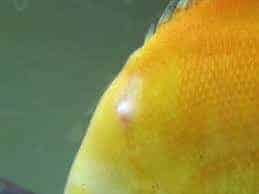
Lymphocystis is a disease that makes discus have growth on its body like could either be pink or white in color. It is sometimes referred to as ‘Cauliflower Disease.’ Sometimes the growth on the body of the fish is the same as the fish’s color.
Table of Contents
- Symptoms of Lymphocystis
- Disease Description And Causes of Lymphocystis
- How Lymphocystis Is Diagnosed?
- Discus Lymphocystis Treatment
- Lymphocystis Future Prevention Tips
- Conclusion
Symptoms of Lymphocystis
The symptoms of lymphocystis are highlighted below:
- Wart-like growth (nodules) on the skin, fins, gills, and mouth of Discus.
- Lesions in the mouth and on parts of the body.
- Exophthalmia (protruded eye) in the eye or behind it.
- When the nodules are too much on the body, the Discus may have difficulty swimming and breathing.
Disease Description And Causes of Lymphocystis
The lymphocytes disease makes nodules that look like warts appear on the body of your discus fish.
Lymphocystis is the result of an infection that is caused by an iridovirus called Lymphocystivirus or Lmphocystis disease virus (LCDV) from a family of viruses known as Iridoviridae.

There are other iridovidal viruses that are disease-causing than lymphocystis viruses such as ranaviruses and megalocytiviruses – these viruses even have a higher mortality rate when they attack fishes.
Be that as it may, the growths that appear on the body of Discus fishes give them an unsightly appearance and they become less marketable.
Lymphocystis affects specific types of fishes – the different strains of the virus have a particular species of fish that they affect. If a strain of lymphocystis does not attack the species of fishes that are susceptible to its attack, it can attack a fish species that is closely related to it.

Can Lymphocystis Kill A Discus Fish?
Yes, Lymphocystis could kill Discus in two cases:
- If the extent to which discus is infected is great, Discus may die.
- If the growth can become infected with bacteria and if that happens, it could kill your Discus fishes.
The lesions that this disease cause appears in varying locations on the body of the fish thus making it difficult to diagnose.
How Lymphocystis Is Diagnosed?
There are three ways to diagnose Discus Lymphocystis disease:
[1] – Skin Scraping
Diagnoses are done by scraping the skin of Discus and the part that is scraped off is then placed under a microscope for analysis. The idea is to make sure that the infection is not a white spot or ich.
[2] – Histology Analysis
Another way to diagnose lymphocystis is by performing a histology analysis. To do this, a veterinarian scraps a part of the skin and lesion on the fish and puts it in formalin to be observed over a few days or weeks.
[3] – By Looking At The Symptoms
How To Identify Lymphocystis From Ich?
- The Lumps Growing On The Skin Of Discus Is Rough: One symptom of lymphocystis is that there are lumps on the skin of the discus and these lumps are rough. When the lumps on the skin of the discus are round and smooth, whatever is happening to Discus is not a result of being infected by lymphocystivirus, instead, it is called a papilloma or a tumor that could be caused by a varying number of conditions.
- Growth On The Skin Cluster Together: When the symptoms (such as growth) appear on discus, an early diagnosis may suggest that the infection could be caused by ich (Ichthyophthirius multifiliis) maybe because the growth is sparse, overtime, however, the growth begin to cluster together either on the skin, fins, mouth, and sometimes gills
- The Disease Can Also Affect The Tissues Of Discus And Cause: Pebbles or nodules (growth) that look like warts on either the skin, fins, and mouth develop as a result of infection by lymphocystis but it does not just stop there. Lymphocystis goes on to attack the tissues within the body of Discus.
- Discus Fishes Could Also Develop Lesions: Inside their mouths or at the base of their dorsal fins.
Discus Lymphocystis Treatment
Much like tumors or viruses, there is no direct treatment for lymphocystis (viruses are difficult and somewhat impossible to treat) and therefore, saying that a treatment for viruses is just like saying that there is a cure for the common cold.
The recommended methods of treating Discus lymphocystis (although, not directly) are:
- Changing Tank Water: This is done by draining 50 percent of the tank water and adding new water by passing it through the clean filter in the tank.
- Treating The Tank Water With A UV: Through UV treatment of tank water and over-filtration, the bacteria in the water are reduced and this allows the immune system of discus to focus on fighting the virus.
- Some experts recommend acriflavine.
- Remove Any Stress Causes: as this could make the symptoms of the disease worse.
- Maintain A Healthy Environment: In which the fish resides, the growth on the body of discus will subside as time passes by.
When in actual sense, what exists is a medication that takes care of the symptoms but never does anything to the virus.
Lymphocystis Future Prevention Tips
Lymphocystis is not so easy to detect even in the aquarium because the disease takes a long time to incubate. The best thing to do is to lower the incidence of stress for your discus.
The ways to prevent Discus lymphocystis include:
- Feed discus with a proper diet.
- Keep tank water clean.
- Maintain a stable water temperature in the tank.
- Maintain a healthy discus environment.
Conclusion
Lymphocystis is a disease that results from an infection caused by a virus from the Iridoviridae family called Lymphocystivirus or Lymphocystis Disease Virus (LCDV). The disease causes growth to appear on the skin, mouth, sometimes gills, and fins of discus and other kinds of fishes. The color of the growth is sometimes white or pink and sometimes, it takes the color of the fish.
It is not very fatal (does not kill discus) except in situations where the infection is severe or if the growth is further infected by bacteria.
There is no treatment for lymphocystis; if left for a few months, the growth will subside however proper care must be given to both discus as well as the tank and tank water in which it resides.

Firas,
Thank you for spending a few minutes to help me. I have had a 120 gallon tank for 4 years with discus.
My water is always perfect/ Pristine – no ammonia, nitrate etc.
I purchased two discus last week. Not sure if this has anything to do with it. 4 of my 9 are literally all by the heater and have white spots. Not sure what these are but I think it’s a fungus. I added ick guard, removed the carbon filter and looking for help. Can I send you some pictures ?
Thank you
Dan
Hi Dan,
You may share the photos on this direct photos sharing website, and send me their links:
https://pasteboard.co/
Hi Firassameer, my name is Cassandra and I would really appreciate your advice concerning my ill discus. I have had her for 10 years, and this is the first time she has had any health problems. She lives by herself in a 20 gallon tank. About a week ago, she laid a clutch of eggs and then ate them. Since then, she has not had any interest in eating. Over the course of the week, she developed small white spots only on her tail. Some are very small like grains of salt, and others are more rounded/three-dimensional. I treated her with ick medicine twice, but the spots didn’t go away. This leads me to believe she may have lymphocystis, especially after reading your article. Her other symptoms include gulping for air at the top of the tank and slight difficulty maintaining equilibrium. She leans a bit to the side while in a resting position, but swims normally/upright. I have done a lot of research to diagnose her illness, and I am currently treating her for nitrate poisoning. The nitrate poisoning and high nitrate level in the tank came as a shock since this tank is so established and carefully maintained. I’ve taken care of my discus very well over the course of 10 years, and nothing in her routine aquarium maintenance schedule/practices have changed. I clean the tank and change the filter cartridge regularly, maintain a constant temperature of 80 degrees F, always use my well water for water changes (there is no nitrate in that water, either), feed her the same food, etc. I have started doing 25% water changes daily to lower the nitrate level & improve overall water quality. Other than that, I don’t know what to do because I can’t be sure which diagnosis is correct. I know this is a lot of information, but I would be very interested to hear your thoughts on the matter. My fish is a member of my family and I sincerely hope I can save her before it’s too late.
Hi Cassandra,
although your comment has a lot of information, my article also has a lot of information, so I advise you the very first thing to do is to double-check the article and try to identify exactly which disease your Discus has according to her symptoms, identifying the exact disease will help you save her, I know this particular disease is hard to identify and since I am not near you I won’t be able to help that much, but I believe the article says it all.
one note to mention, changing the water 25% daily for a long time is not a healthy practice as this will not make the water quality stable for the fish, normally it should be done when needed or when treating for several days.
Another thing, I know you said you are maintaining 80F temp, this is not good for healing, better to raise it to 86 to 89F, this is mandatory and will help a lot your Discus to fight the disease no matter what the disease is, also warm water like this will help your fish to ease out the bloat issue (in case if it has bloating as well), and if it does have it, then better to check my other tutorial on how to treat Bloating.
How Do You Treat Discus Bloat? – Discus Dropsy and Bloating Cure
Wish you luck with your Discus, I know it is valuable.